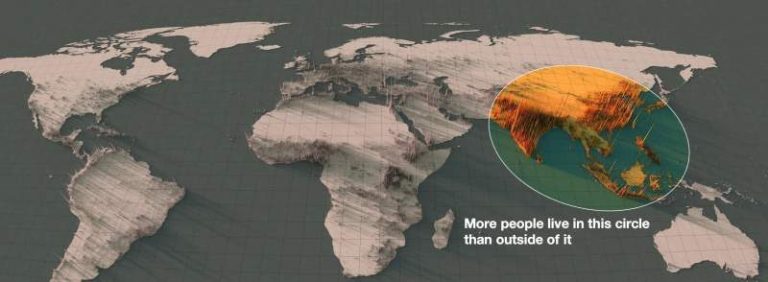More than 50% of the world’s population lives in this circle.
Do you think it’s a coincidence?

Let’s zoom into the region to break down the situation.

India and China together account for 2.8 B people, or 35% of the world’s population.
But many other neighboring countries also have a massive population: Indonesia has 274M, Pakistan 230M, Japan 126M, Philippines 114M… And that’s just those with over 100M people. All these countries together amount to a bit over 50% of the world’s population.

The Root of East and South Asian Population
Let’s dive into the biggest ones. First, we have India.
1. India
I analyzed India in depth with Pakistan and Bangladesh in an article about the Indian subcontinent. If you have read the article or thread, or already understand why India is so populous, skip this section. If not, you might want to go there now, or simply follow this short version:
- The Indo-Australian plate hits the Eurasian plate
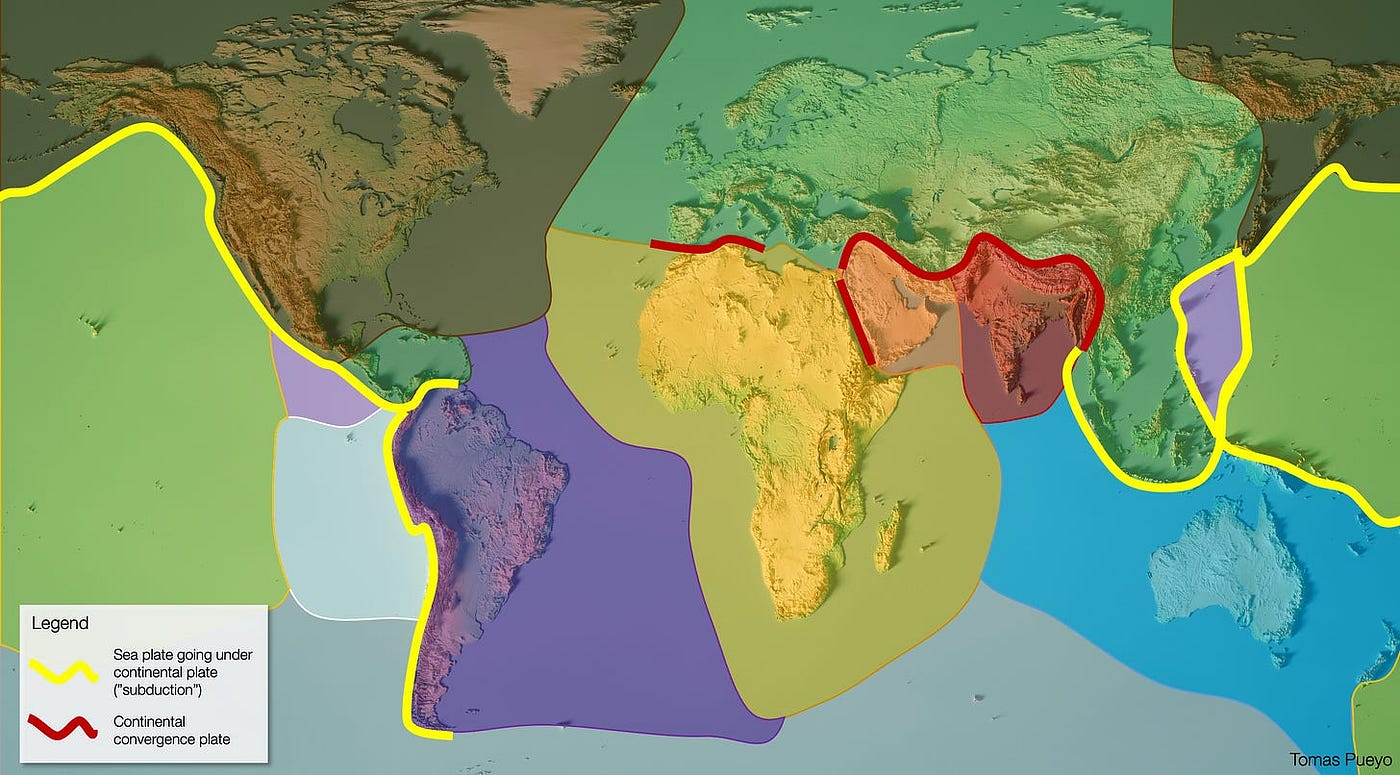
2. The collision raises the land.

3. This creates the biggest mountain range in the world, formed by the Himalayas, Tibet, Hindu Kush, Hengduan Shan…

4. The weight is so heavy that these mountain ranges fall towards the Earth. The regions around it fall with it, becoming flatter, and creating valleys.

5. Winds with lots of humidity come from the Indian Ocean, hit the Himalayas, go up, air gets colder, water condenses and rains down.
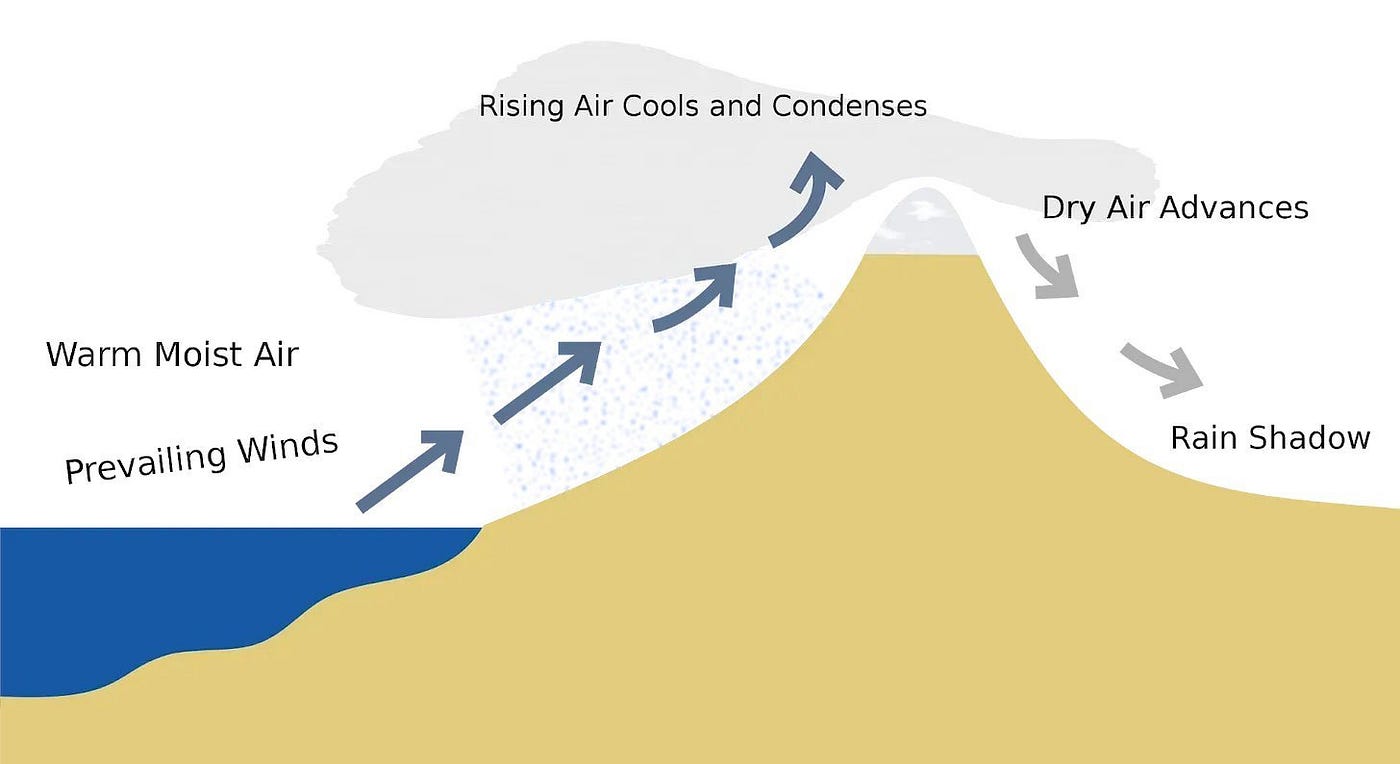
This images shows that: India is green on the left, Tibet is dry on the right.

6. Some water rains directly on India — making a lot of it fertile — and a lot of the rest falls in the Himalayas and flows down. All this water concentrates in the Ganges valley, making it highly humid and irrigable.
7. The Ganges brings sediments with it, which fertilize the Ganges and whatever area it floods.
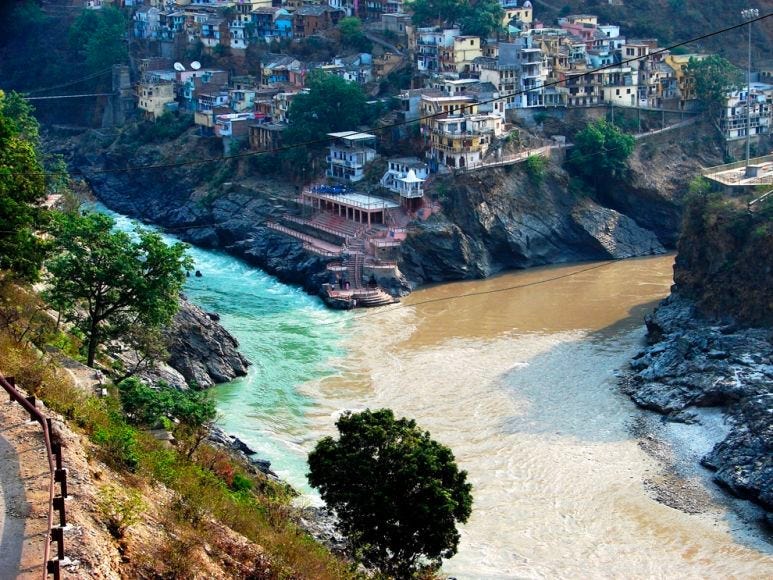
8. Rains, fertilizer, rivers for irrigation, and heat: Perfect conditions for agriculture, which makes India one of the biggest producers of food in the world. Food = population.

Now there’s one more thing: Why does the wind invade India with lots of water in it? In this part of the world, it’s not common.

The Horse Latitudes tend to have deserts, because wind falls down on the land without any water. Why?
Because of the rotation of the Earth.

The equator is the hottest part of the world because the Sun hits it directly. It evaporates water and heats up air. Hot air is lighter, so it goes up, it hits the colder air of the upper atmosphere, so water condenses and rains down. But the air keeps flowing because of the rotation of the Earth! And it falls down in the Horse Latitudes, devoid of water. With so much wind going down, other winds have a hard time going there, and there’s no rain.
So why does it not work in India? Because of the monsoon.

In summer, monsoon rains beat this force of dry air and invade India with humid winds. How come?
Because Eurasia is so big.

This part of the world is the only one with a southern ocean and a northern continent. What happens in summer is:
- The Indian ocean and Eurasia heat up.
- In the Indian ocean, this heat evaporates water, and the air fills with moisture.
- But the land warms up faster than water, so Eurasia gets much hotter than the Indian ocean, air goes up above Eurasia, it creates a vacuum, and the hot, humid air from the Indian ocean invades India and rains down at the Himalayas

In summary, India is very populated because it’s very fertile, and it’s fertile because of the heat and humidity.
- The heat comes from its subtropical position.
- The humidity comes from the monsoons.
- The monsoons in turn come from Eurasia being so big and the Indian ocean being just south of that.
Within India, the Ganges river valley is especially fertile because:
- The monsoon winds are stopped by the Himalayas, water rains down, creating rivers that can irrigate the region.
- They also bring sediments with it, which fertilizes the soil.
- It’s a valley that concentrates all these waters and sediments because the weight of the Himalayas make it fall compared to the region farther south.
In summary, all of this is created by the Indo-Australian plate hitting the Eurasian plate. That’s what causes the monsoon and the Himalayas, which together make India fertile.
OK, we’ve explained 1.4 B people with one geologic accident. But what about the rest?
2. Pakistan, Bangladesh, and Nepal
This is the same story!

Pakistan is mostly the Indus valley. Look where Pakistanis live vs. the Indus river basin:
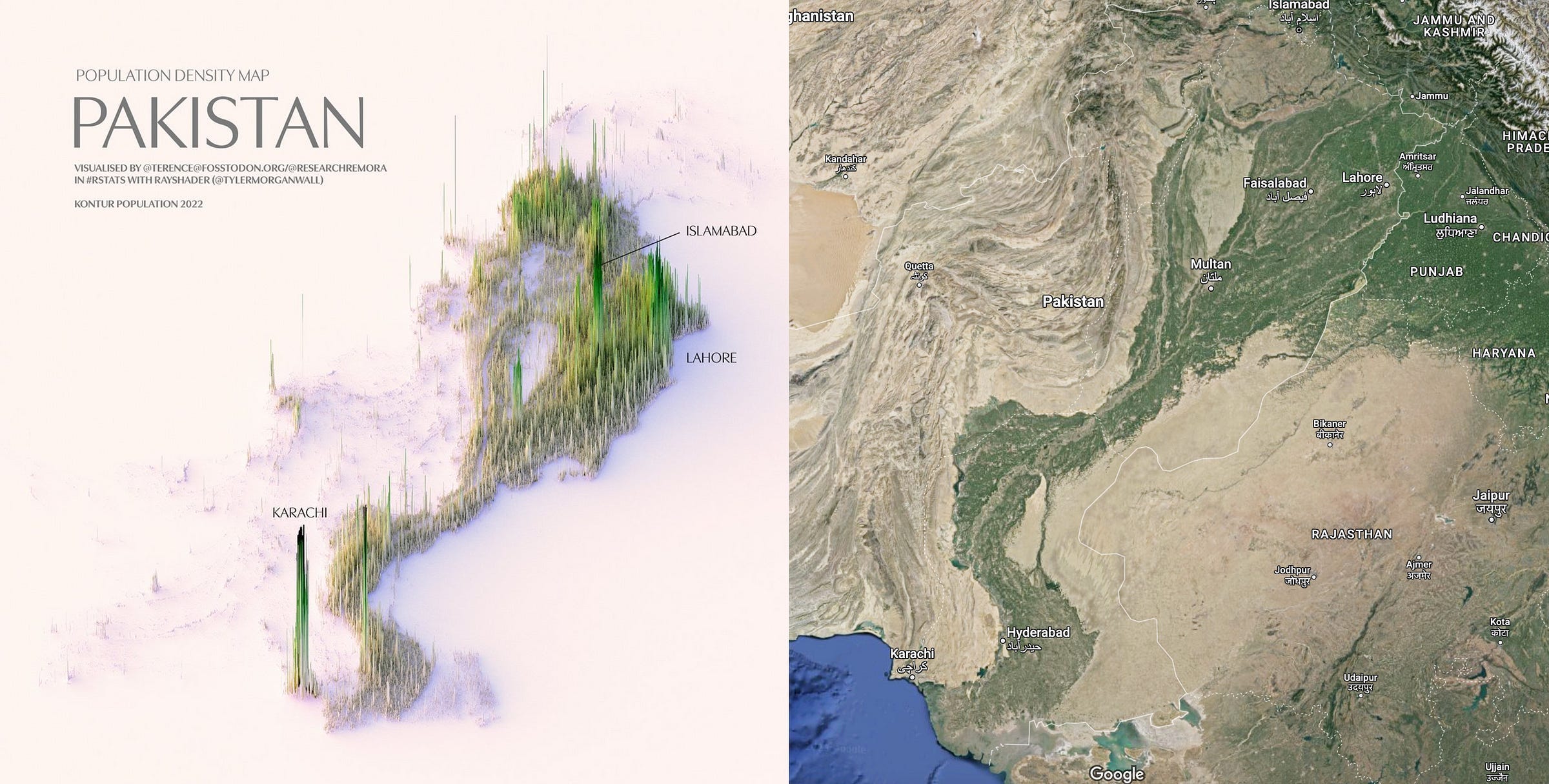
In other words, the story of the Ganges is the same for the Indus river, which means it’s the same for Pakistan: The population was born out of the impact of the Indo-Australian Plate with the Eurasian Plate, creating mountain ranges (in the case of Pakistan, the Himalayas and Hindu Kush) and the monsoon.
And the story of Bangladesh, of course, is the same as that of the Ganges, as Bangladesh is just the mouth of the Ganges, which merges with the Brahmaputra inside the country.

Meanwhile, Nepal is just like India: All its population is concentrated on the Ganges Valley, and barely anybody lives up the Himalayas:

So the 1.8B people living in the Indian subcontinent can be understood by the impact of the Eurasian and Indo-Australian tectonic plates.
What about China?
3. China
In What China Wants, I went deep into how China’s geography determined its history. Jump this section if you know the story. If not, here’s the short version:
94% of Chinese live east of the Hu Line:

And notice where: In the big red area on the coast, a circle in the middle (the Sichuan Basin), and the coast. You can see these plains clearly here:

Unsurprisingly, these plains are the most fertile.

Why? Because they have what it takes:
- Temperate climate
- Flat
- Fertilized and irrigated by rivers
- Humid
They’re fertilized and irrigated by the Yellow and Yangtze rivers (and, in a lesser extent, the Pearl River and smaller ones).

Obviously, these rivers all come from Tibet and the rest of mountains from the region, most of which that are caused by the collision between the Indo-Australian Plate and the Eurasian Plate.
They’re humid because of the rivers and… because of the monsoon! Which also hits China, for the same reasons as India: Eurasia is a big landmass, air goes up in summer, and moist winds from the sea invade the country and drop their rains.

And they’re flat because… well, because of the Pacific Plate hitting the Eurasian Plate!

In other words, you can trace back all the reasons why China is fertile (and hence populous) to how the Indo-Australian and Pacific plates subduct below the Eurasian Plate!
And the same logic is valid for the Koreas: Their flat valleys have dense population because they’re very fertile thanks to the monsoons and sediments brought down by the rivers.

4. Indochinese Peninsula
Now you’re probably noticing a pattern… That’s right! The same thing is true for the rest of continental Southeast Asia. All its main rivers are born in the Himalayas, Tibet, or the other ranges of mountains created by the collision between Eurasia and Indo-Australia.

Each one of the biggest countries in this area of the world is built around the major rivers created by the Himalayas:
- Pakistan around the Indus Valley
- Northern India mainly around the Ganges
- Bangladesh around the Ganges and the Brahmaputra
- Burma around the Irrawaddy

- Thailand around the Chao Phraya
- Vietnam, Thailand, and Cambodia around the Mekong
- Northern Vietnam around the Red River
- China around the Yellow, Yangtze, and Pearl rivers
These are the main river basins in East Asia.

It’s not a coincidence that these rivers traverse these countries. These rivers created these countries. They carved valleys over millions of years, and these valleys, protected by mountain ranges, have each created fertile grounds for a different civilization to emerge.
You can see it clearly comparing the topography & river maps (left) with the pop density map (right).

This shows at the same time the river valleys of Southeast Asia and their population densities. We can see that the Irrawaddy created Burma; the Chao Phraya, Thailand; the Mekong, Cambodia and South Vietnam; the Red River (and also the Cả River, not displayed here), Northern Vietnam.
And so you can also track back the population of Southeast Asia to the same root cause:
- The Eurasian and Indo-Australian plate collision create all these rivers.
- The rivers, in turn, carve out valleys, flatten them, fertilize them, and irrigate them.
- These regions are also warm thanks to their latitude, and moist thanks to the same monsoon that hits India and China, caused by the same winds from the same plate tectonics.
- These conditions created the fertility needed to spawn so many people around Southeast Asian rivers
5. Asian Islands
So far, we’ve explained the population of south and east continental Asia thanks to the same plate tectonics: Eurasia’s massive size, and its collision with the Indo-Australian and Pacific plates. But of course, that can’t work for the islands, right? Indonesia, Japan, and Philippines account for more than 500M people, but they can’t be served from rivers sourced in the Tibet.
No, but they’re still caused by the same plate tectonics!
In Why Is Java So Weird?, I explained the source of the population of Java.
The one-liner is that Java accounts for 55% of Indonesia’s population because of its volcanoes, which make the island hyperfertile.

But this is not only true for Java. It’s true for most of Indonesia: Usually, the most fertile parts are those with the most active volcanoes.
And guess what causes the volcanoes?

That’s right! Our beloved Eurasian Plate colliding with the Indo-Australian Plate! This is how the volcanoes are formed:

A reminder on the plates:

So yes, a big chunk of Indonesia’s population is also created by the collision of the Indo-Australian and Eurasian plates!
Oh but what do you see just northeast of Indonesia? The Philippines! And what’s in the Philippines? Volcanoes!

And why are there volcanoes there? Because of the subduction of the Philippines Sea Plate below the Eurasian plate! And what is north of the Philippines, along the same tectonic plate border?
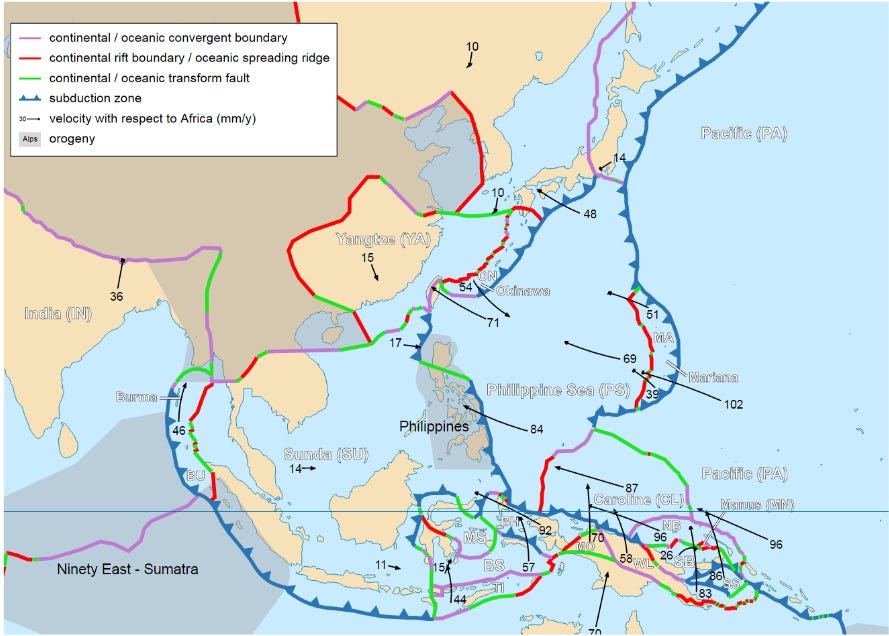
That’s right. Indonesia, the Philippines, Taiwan, and Japan have the same profile: Islands formed by the collision between the Eurasian plate and other plates (Indo-Australian, Philippines Sea, and Pacific), with lots of volcanoes making them extremely fertile.
Conclusion: Why Is 50% of the Population in That Circle?
In summary, the reason why so many people live in that circle is because a massive continental plate — the Eurasian plate — is aggressively colliding against other tectonic plates.
The collision with the continental crust of the Indo-Australian plate creates a massive mountain range, which then stops the winds, gathers their water, and distributes it in many different rivers, each of which spawned a civilization.
Where the Eurasian plates collides with oceanic crust, the oceans go below the Eurasian plate, creating arcs of volcanoes with hyperfertile soil that spawn more civilizations. This happens with:
- The Indo-Australian Plate at the level of Indonesia
- The Philippine Sea Plate with the Philippines
- The Pacific Plate with Japan
Because all these collisions happen near the equator close to oceans, all these regions are hot and humid. And since the Eurasian plate is so huge, it creates monsoons that attract further moisture inland.
There’s only one question left: Why is the Eurasian plate hitting three other plates so brutally?
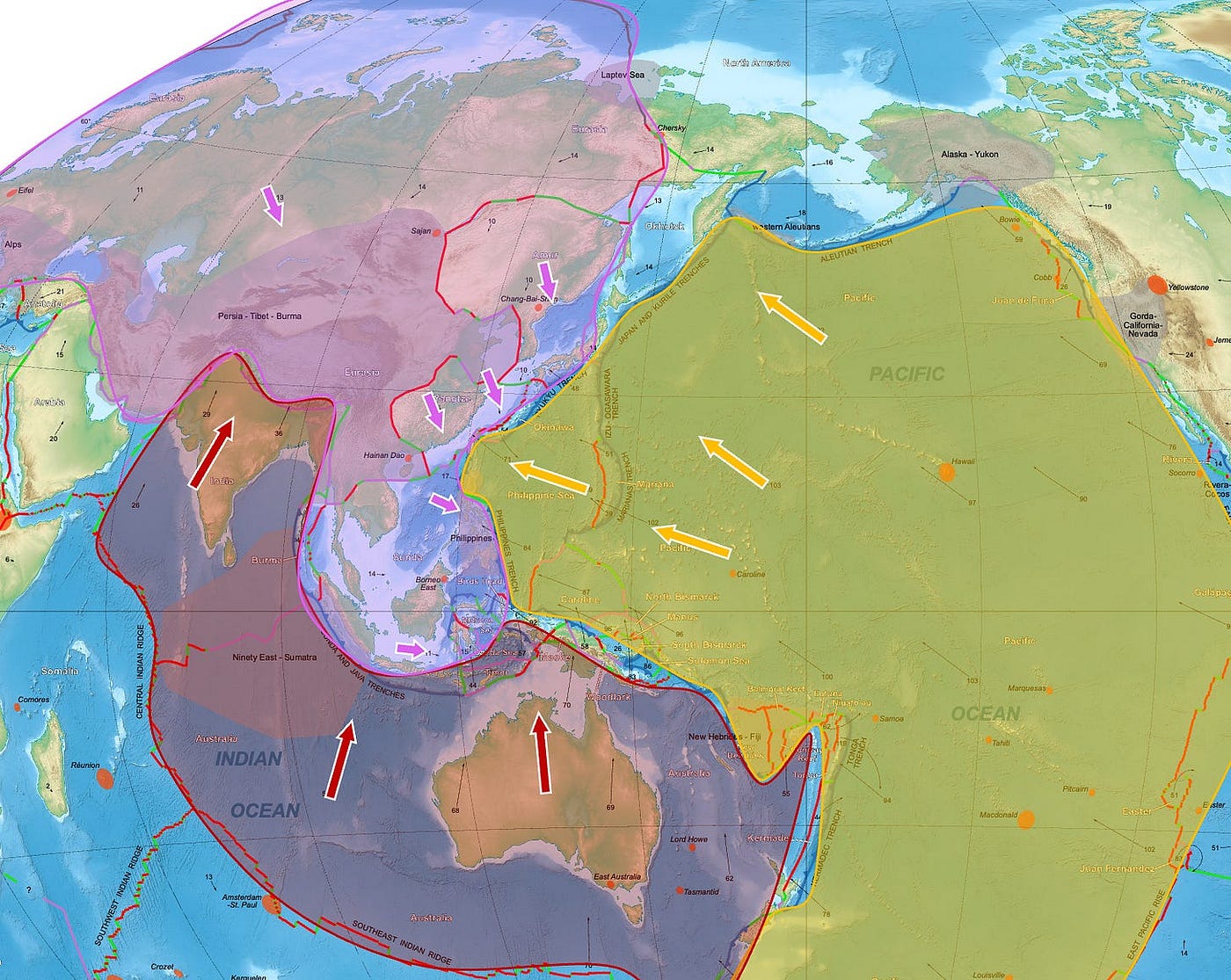
While the Eurasian Plate is turning clockwise and going southeast on its eastern side, the Indo-Australian Plate is charging north while the Pacific Plate, together with the Philippines Sea Plate, are barreling west.
This is like a three-sided head-on train wreck.

Except this one created half of human life on Earth.
If you’re interested about how the world works, and especially about how the shape of the Earth influences us to this day, subscribe to receive my emails! Scroll down until you see my name and click on the little envelope to the right.




